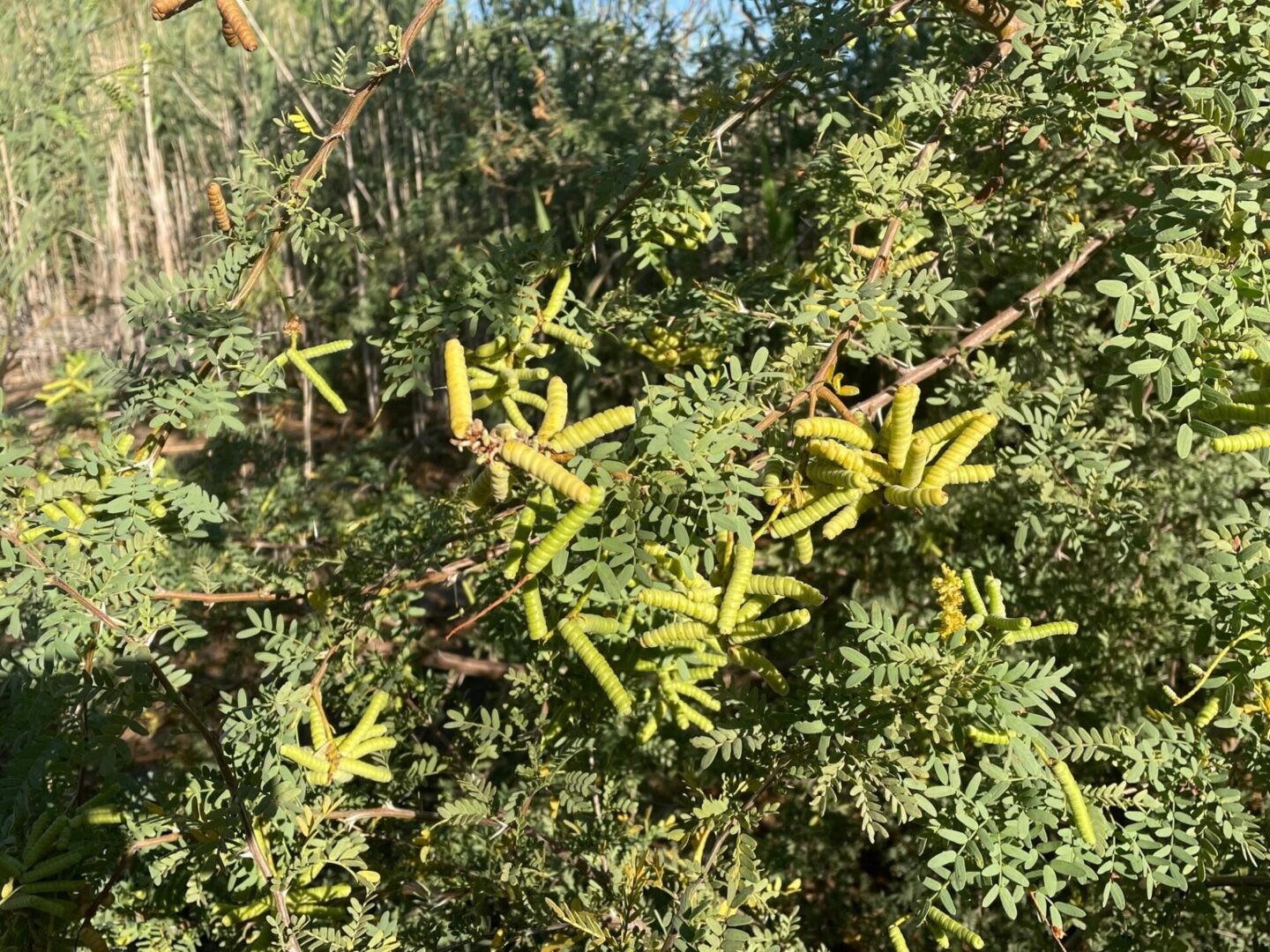The Screwbean Mesquite

WHAT WETLANDS PARK TREE WITH THE “SCREWY” FRUIT GIVES SCIENTISTS REASON FOR CONCERN?
If you’ve taken any of the trails in Clark County Wetlands Park, you’ve likely encountered screwbean mesquite trees (Prosopis pubescens). Their distinctive fruit earns them their name. In late summer, the trees produce light green seed pods that grow in a very tightly coiled spiral shape. However, mature, tan-colored pods (typically two to six inches in length) can be found on the ground near the tree stands year-round, and some may remain on the trees over winter as well. Alarmingly, the trees are suffering die-offs in the Park and most of the Southwest, which has raised concerns with scientists and ecologists in the region.
By tree standards, screwbeans are small trees, usually topping out about 20 feet tall. With multiple trunks and spreading branches, the trees can sometimes grow wider than tall. The trees have deep root systems and are found in habitats where the water table is moderately high. They are deciduous, typically losing their short, narrow leaves and going dormant in winter. The screwbeans differ from their cousins, the honey mesquites (Prosopis glandulosa; also found in the Park) by a more “upright” appearance and having smaller, paired V-shaped silvery thorns. Their leaves are also smaller, and they have fewer leaves in every cluster. Instead of having red stems like the honey mesquites, the screwbeans’ stems are a duller gray color.
Screwbean pods are a favored food of many insects, birds, and mammals, including ground squirrels, coyotes, and raccoons. Pods found while exploring Wetlands Park trails often have tiny holes in them – evidence of a small insect called a borer drilling to get inside. The reason: the pods are very sweet and protein-packed. Historically, the pods have been prized food by Native people and are popular with many people today. The pods’ sweetness comes from fructose sugar, which doesn’t require insulin to be metabolized. The pods also contain about 35% protein, far more than soybeans. They also contain about 25% fiber. Some research suggests that the gluten-free ground screwbean mesquite meal or flour, with a low glycemic index of 25, can help regulate blood sugar.
Native people would grind the mature tough mesquite pods and seeds into a meal. Screwbean pods are extra tough and required a period of “pre-cooking” in a damp underground pit before drying and grinding. By adding a little water to the ground mesquite meal, people formed small, round cakes that when dried were sliced and fried like polenta, used to thicken stews, made into bread, or eaten “as is”. These meal cakes were very “shelf-stable” and could be kept for years until needed. By diluting the ground mesquite meal, they made a refreshing drink. If they allowed that drink to ferment, the concoction became a fizzy alcoholic drink.
Additionally, some Native people used screwbean thorns as needles and spearpoints and the hard wood in construction. Other uses have included: boiling the black sap found in the trees (also called tar or resin) and diluting it with water to make an eye wash and antiseptic for open wounds, a treatment for sore lips and chapped skin, as a sunburn lotion, and as a treatment for venereal disease. Others used the sap as a hair dye, as glue to mend pottery, or when boiled and diluted, a paint for pottery. They also used the inner tree bark in basketry.
But that’s not all! Screwbeans’ yellow flowers are very attractive to native bees, honeybees, and many kinds of butterflies. They can also be collected and boiled to make tea. The tea is said to be useful for headaches and stomach trouble, to cure conjunctivitis, and heal painful gums. The flowers are also roasted and pressed into balls as another food source. Mesquite wood was and is used today in cooking, imparting a pleasant, distinctive scent and flavor to food.
What a great tree, for wildlife and for people! Unfortunately, mature screwbean mesquite trees are dying off in disturbing numbers, including those in the Park. The good news is that scientists and ecologists throughout the region are working together to determine the cause (or causes) and come up with solutions. The working theory is that there are complex causes for the die-off, likely the result of climate change. The Park is involved in this effort, monitoring 60 affected trees for die-back, insect infestation, and fungus growth. It is also monitoring several trees inoculated with the “canker” that forms on affected trees to study the spread.
One interesting finding is that young trees and regrowth from coppiced trees (ones that have been “hard cut” to the ground) results in healthy growth—at least until the trees reach maturity.
It is hoped that through the collaboration of scientists, project directors, nonprofit organizations, and private property owners, the story of the screwbean mesquite will have a happy ending and possibly serve as a model for the management of other iconic desert species that are threatened by our changing environment.
– By Constance Carlson, Director of Communications
Please enjoy this YouTube video:
“Prosopis pubescens, Screwe Bean Mesquite”
